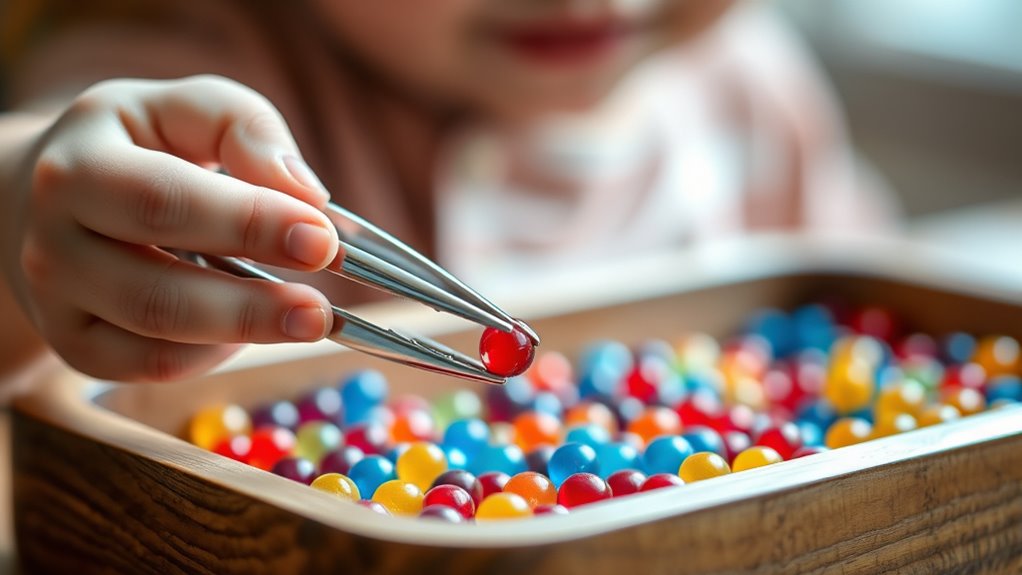Using tongs and beads for fine motor play helps you develop your child’s hand strength, coordination, and dexterity, which are essential for tasks like writing and buttoning. Activities like sorting, patterning, and threading beads not only make learning fun but also improve grasp, control, and concentration. As your child progresses from large to small beads, they build skills step by step. Keep exploring different activities to see how these simple tools can boost their fine motor skills over time.
Key Takeaways
- Using tongs and beads enhances fine motor skills critical for writing and daily tasks.
- Sorting and threading beads with tongs develop hand-eye coordination and precision.
- Creative activities like jewelry making foster imagination and improve dexterity.
- Color-coding and pattern activities strengthen pattern recognition and sequencing abilities.
- Progressively challenging tasks build coordination and refine small muscle control over time.

Using tongs and beads is a simple yet effective way to boost your child’s fine motor skills. When you incorporate these tools into play, you’re helping your child develop beneficial skill development that will serve them well in everyday tasks, from writing to buttoning. The act of grasping, pinching, and transferring beads using tongs enhances hand-eye coordination and strengthens small muscle groups in the fingers and hands. These foundational skills are essential for more complex hand movements and can improve your child’s dexterity over time.
Using tongs and beads develops fine motor skills vital for daily tasks like writing and buttoning.
As you introduce tongs and beads into play, you’re opening up a world of creative activity ideas that encourage learning through fun. For example, you might set up a colorful bead sorting game, where your child uses tongs to pick up beads of different shapes, sizes, or colors and place them in designated containers. This activity not only promotes fine motor control but also introduces concepts like sorting, categorizing, and counting, making it both educational and engaging. You can also create patterns or sequences with beads, encouraging your child to develop their visual-motor integration as they replicate designs using tongs. These activities help refine their precision and concentration, essential components of fine motor skill development.
Another creative activity idea involves using themed beads—such as letter beads or animal-shaped beads—to make jewelry or craft projects. Your child can use tongs to carefully thread beads onto strings, which enhances their pincer grip and hand stability. This kind of play fosters patience and focus while providing a sense of accomplishment once they complete their creations. Additionally, incorporating beads into storytelling or role-play scenarios can make the activity more meaningful. For instance, pretending to prepare a “bead meal” or “decorate a necklace” can turn fine motor practice into an imaginative adventure.
You might also consider color-coding activities, where your child sorts beads by color using tongs, helping them recognize patterns and improve their ability to manipulate objects precisely. These activities are adaptable for different skill levels; you can start with large beads and simple tasks, then gradually introduce smaller beads and more complex arrangements. As your child manipulates tongs to pick up beads, they’re refining coordination and developing the beneficial skills needed for writing and other fine motor tasks.
Frequently Asked Questions
What Are the Best Age Groups for Tong and Bead Activities?
You should target early childhood for tong and bead activities, as they help develop fine motor skills effectively. Children around ages 3 to 6 benefit most, as they’re refining hand-eye coordination and grasping abilities. By engaging in these activities, you encourage your child’s dexterity and precision, laying a strong foundation for later skills like writing. Keep activities fun and age-appropriate to maintain their interest and maximize learning.
How Can I Make Bead Activities Safer for Young Children?
Imagine a colorful tray of beads and a child carefully picking them up with tongs. To make this activity safer, you should childproof the area by keeping small beads out of reach when not in use and supervising closely. Use non-toxic materials for beads and tongs, and opt for larger beads that are less likely to be swallowed. These childproofing techniques help create a secure, enjoyable environment for your little one.
Are There Different Types of Tongs Suitable for Various Skill Levels?
Yes, different tongs suit various skill levels. For beginners, you should choose tongs for beginners, which are typically easier to grip and control. As children develop their fine motor skills, you can introduce specialized tongs for advanced use, designed for more precision and strength. This progression helps children build confidence and coordination gradually, making the activity both safe and engaging as they improve their skills.
How Do I Incorporate Educational Themes Into Bead Activities?
You can incorporate educational themes into bead activities by selecting beads that match your learning goals, such as alphabet beads for literacy or number beads for math. Use themed patterns or storytelling to make the activity engaging, encouraging cognitive development. For example, create a story with beads representing characters or concepts. This approach promotes themed learning, enhances fine motor skills, and supports cognitive growth through meaningful, hands-on experiences.
What Are Some Alternative Materials for Beads to Enhance Sensory Play?
You can use materials like dried pasta, rice, or small pebbles to enhance sensory texture and support fine motor development. These alternatives allow kids to explore different tactile sensations while practicing grasping and pinching skills. Incorporate scoops or tweezers to make the activity more engaging. Always supervise to make sure safety, and choose materials that are safe and appropriate for the child’s age to maximize sensory exploration and motor skill growth.
Conclusion
Now that you’ve explored the world of tongs and beads, you’ll see your little one’s fine motor skills soar to heights you never imagined possible—faster than a rocket, stronger than steel, more precise than a surgeon’s hand! Keep encouraging these playful activities, and watch as tiny fingers become unstoppable superstars of dexterity. With each pick-up and placement, you’re revealing a future of confident, capable movers who can conquer anything—one bead at a time!









